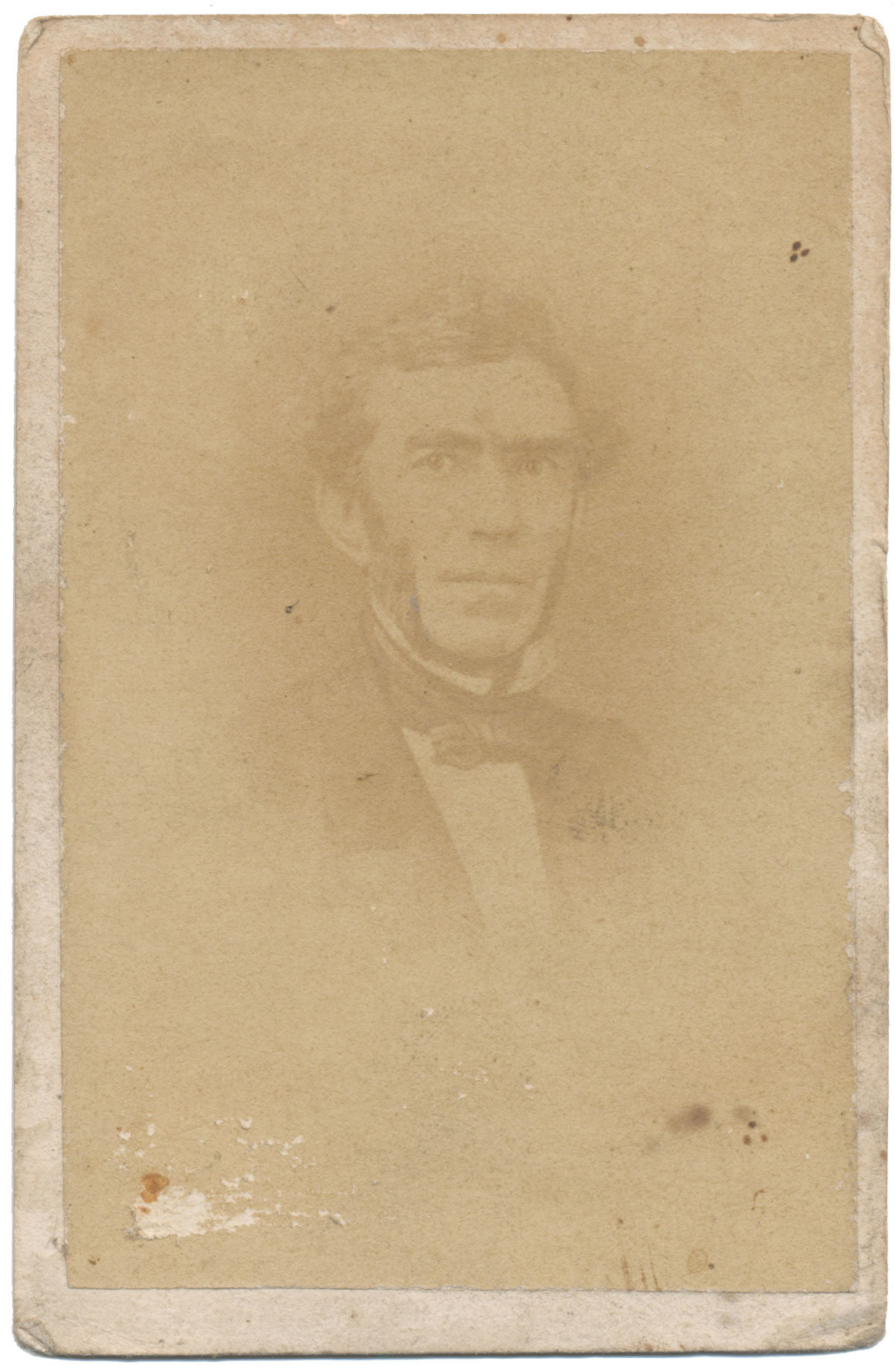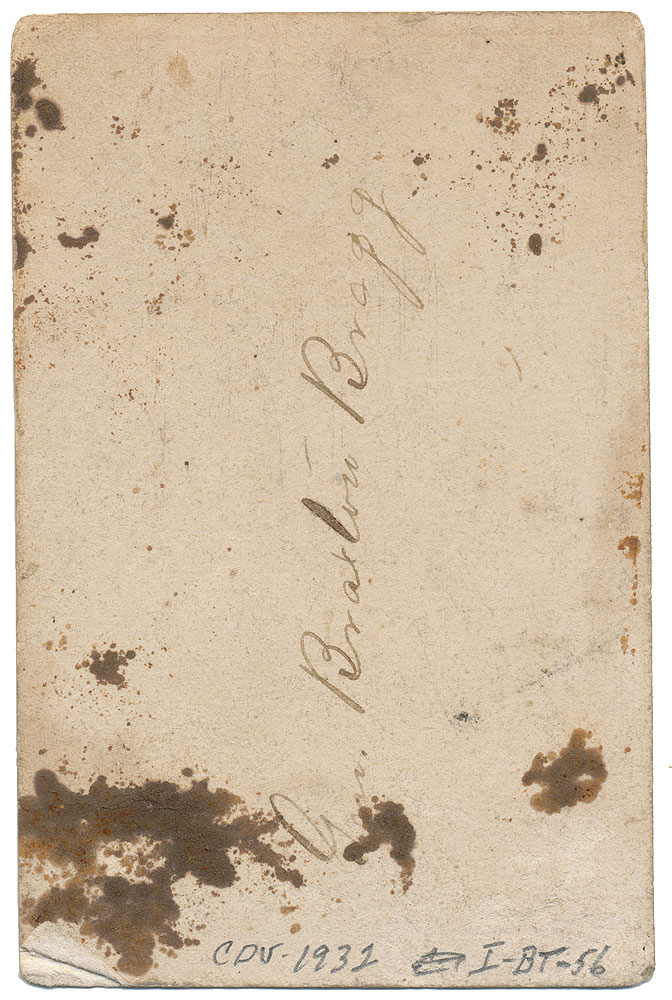site search
online catalog
CDV OF GENERAL BRAXTON BRAGG WITH PERIOD INK ID

Hover to zoom


$125.00
Quantity Available: 1
Item Code: 1138-56
Shipping: Determined by Method & Location of buyer
To Order:
Call 717-334-0347,
Fax 717-334-5016, or E-mail
Image is a pre-war chest-up view of Bragg in civilian clothes.
Clarity is good but the contrast is light. Paper is toned and the mount has light surface dirt. There is also some rubbing to the paper in the lower left corner.
Reverse has several scattered ink stains and a nice period ink ID of “GEN. BRAXTON BRAGG.” There is also some collector information in pencil at bottom.
From the collection of the late William A. Turner.
Braxton Bragg was born in Warren County, North Carolina, March 22, 1817. He was graduated fifth in the class of 1837 at the United States Military Academy, and received his lieutenancy in the artillery. He served mainly in Florida during the Indian troubles, until 1843, and then was in garrison at Fort Moultrie until 1845, when he took part in the occupation of Texas.
In the subsequent war with Mexico he served with distinguished gallantry, and was brevetted captain for conduct in defense of Fort Brown, major for valor at Monterey, and lieutenant-colonel for his special services at Buena Vista. He became captain, Third Artillery, June, 1846, was on the staff of General Gaines, and on garrison duty until 1855, when he declined promotion to major of First Cavalry.
He resigned January 3, 1856, and became a planter at Thibodeaux, Louisiana, serving his State, 1859-61, as commissioner of public works. In February, 1861, he was put in command of the army of Louisiana, and on March 7th was commissioned brigadier-general in the provisional army of the Confederate States, and assigned to the command of the troops and defenses at Pensacola, which he held until January 27, 1862, in the meantime having been promoted major-general and lieutenant-general and assigned to the command of the department of Alabama and West Florida.
In March, 1862, he marched his forces to Corinth, whence in command of the Second Corps of the army he participated in the movement against Grant and the battle of Shiloh. In this famous combat Albert Sidney Johnston fell, and Beauregard succeeded to the general command, while Bragg was promoted general and assigned to the command of the army of the Mississippi, with Polk, Hardee and Breckinridge as his corps commanders.
When after the evacuation of Corinth the army had retired to Tupelo, Beauregard, on account of illness, turned over the command temporarily to Bragg and went to Mobile. Beauregard was thereupon relieved and Bragg appointed as his successor. He was now in command of the department and all the forces arrayed against the Federal invasion between the Mississippi river and Atlanta, except the command of General Kirby Smith, in East Tennessee.
He planned a campaign into Kentucky before Buell was ready to oppose him, hoping by a bold offensive movement to arouse the friends of the Confederate cause in the Border States and drive the enemy beyond the Ohio. He transferred his troops to Chattanooga, and set out on his northward movement about the middle of August, Kirby Smith moving with a separate command in co-operation.
At Munfordville he captured over 4,000 Federal soldiers, and then moved his army to Bardstown, and with his staff joined Kirby Smith at Lexington, where on October 4th, Hon. Richard Hawes was installed as Confederate provisional governor of Kentucky. At Perryville he encountered Buell's army and was victorious at every point, striking such a severe blow that he was able subsequently to move without loss to his large trains of captured stores, back to Knoxville.
Preparing at once for a movement into Middle Tennessee he reached Murfreesboro November 26, 1862, about the date when General J. E. Johnston was appointed to the general command of the new department of the West, including the forces of Smith, Bragg and Pemberton.
On December 30th-31st he repulsed the advance of Rosecrans' army upon his position, gaining a notable victory, but on January 2nd he was himself repulsed in an attack on the Federal left. He retreated to Tullahoma, where Johnston was empowered to relieve him of command if that commander thought best, but the result of a visit by Johnston was the retention of Bragg in command.
In the latter part of June, 1863, he withdrew to Chattanooga, and thence in September, on account of the Federal forces appearing to the south, fell back into Georgia, where near the Tennessee line the great battle of Chickamauga was fought by the Confederate army under his command September 19th and 20th.
It resulted in the complete rout of Rosecrans, the command of George H. Thomas alone holding its ground during the battle. Subsequently he besieged the beaten Federals at Chattanooga and sent Longstreet against Knoxville. When the beleaguered Federals were on the point of starvation they were heavily reinforced by Grant, and the Confederates were forced to retire from Missionary Ridge.
On February 24, 1864, he was assigned to duty at Richmond, under direction of the President, charged with the conduct of the military operations of the armies of the Confederate States. In November following he was given command of the department of North Carolina, and in January, 1865, he commanded the army at Wilmington, and the troops of his department in the final operations against Sherman including the battle of Bentonville.
After the surrender at Appomattox he accompanied President Davis through South Carolina and into Georgia, and after peace was restored, having lost all his property, he became engaged as a civil engineer at New Orleans, and superintended harbor improvements at Mobile.
He died at Galveston, Texas, September 27, 1876. He was an officer of remarkable industry and conscientiousness, and unspotted character. He never praised others nor allowed himself to be flattered. His devotion to duty led him to neglect those amenities of social life which are valuable even in war, and he suffered in consequence, but no one ever questioned his patriotism, or his courage.
Braxton Bragg was buried in Magnolia Cemetery in Mobile, Alabama. [ad] [ph:L]
~~~~~~~~~~~~~~~~~~~~~~~~~~~~~~~~~~~
THIS ITEM, AS WITH ALL OTHER ITEMS AVAILABLE ON OUR WEB SITE,
MAY BE PURCHASED THROUGH OUR LAYAWAY PROGRAM.
CLICK HERE FOR OUR POLICIES AND TERMS.
THANK YOU!
Inquire About CDV OF GENERAL BRAXTON BRAGG WITH PERIOD INK ID
Most Popular
Historical Firearms Stolen From The National Civil War Museum In Harrisburg, Pa »
Theft From Gravesite Of Gen. John Reynolds »
Selection Of Unframed Prints By Don Troiani »
Fine Condition Brass Infantry Bugle Insignia »
Large English Bowie Knife With Sheath 1870’S – 1880’S »
Imported (Clauberg) Us Model 1860 Light Cavalry Officer's Saber »
featured item
1/4 PLATE THERMOPLASTIC CASE WITH AMBROTYPE OF WOMAN & TINTYPE OF 2/LT. BAKER 20TH PA. INFANTRY – THE GREAT RAILROAD STRIKE OF 1877
Left half of this hard case houses an ambrotype of a finely dressed woman. Her cheeks and forehead are tinted. The image is matted, framed, and under glass as is typical. The right side of the case holds an 1877 tintype image of S. Charles Baker in… (1221-53). Learn More »


